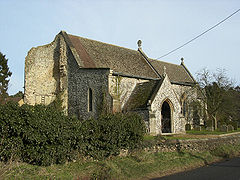Cockley Cley is a village and civil parish in the English county of Norfolk. The village covers an area of 17.94 km2 (6.93 sq mi) and falls within the district of Breckland.
| Cockley Cley | |
|---|---|
 All Saints Church | |
Location within Norfolk | |
| Area | 17.94 km2 (6.93 sq mi) |
| Population | 232 (2011)[1] |
| • Density | 13/km2 (34/sq mi) |
| OS grid reference | TF792042 |
| Civil parish |
|
| District | |
| Shire county | |
| Region | |
| Country | England |
| Sovereign state | United Kingdom |
| Post town | SWAFFHAM |
| Postcode district | PE37 |
| Dialling code | 01760 |
| Police | Norfolk |
| Fire | Norfolk |
| Ambulance | East of England |
History
editThe village's name is of Anglo-Saxon origin and derives from the Old English for a "clay hill shrouded in trees".[2]
In the Domesday Book, Cockley Cley is recorded as a settlement of 32 households located in the hundred of South Greenhoe. In 1086, the village was divided between the estates of King William I and William de Warenne.[3]
Cockley Cley is the site of significant defensive infrastructure built during the Second World War, including a rare example of an "Allan Williams Turret" designed to mount a Lewis gun in an anti-aircraft role.[4]
In August 1974, a decapitated corpse of a woman was discovered near the village. As of 2023, the woman has not been identified.[citation needed]
Between 1975 and 2004, Cockley Cley was home to a mock Iceni village visitor attraction. The site reopened briefly in 2014 as the Iceni Centre but was subsequently forced to close due to dwindling customer numbers.[5]
Geography
editIn the 2011 census, Cockley Cley was recorded as having 232 residents living in 117 households.[6]
The village falls within the constituency of Mid Norfolk and is represented at Parliament by George Freeman MP of the Conservative Party.
All Saints' Church
editCockley Cley's parish church is one of Norfolk's 124 existing Anglo-Saxon round-tower churches. The church was significantly remodelled in the nineteenth century by the architect Richard Phipson. The church tower collapsed on 29 August 1991 and has not been rebuilt.[7]
War memorial
editCockley Cley's war memorial is a marble plaque located inside All Saints' Church which lists the following names for the First World War:
- Corporal William B. Root (1893–1916), 8th Battalion, Royal Norfolk Regiment
- Corporal Frederick Atter (1896–1917), 9th Battalion, Royal Norfolk Regiment
- Lance-Corporal Wallace G. Rungary (d.1918), 1st Battalion, Royal Norfolk Regiment
- Fireman Frederick W. Barker (1887–1915), S.S. Sailor Prince
- Private Henry Norman (1885–1916), 14th Battalion, Gloucestershire Regiment
- Private Charles R. Wilding (1883–1915), 8th Battalion, Royal Norfolk Regiment
- F. Draper
- E. Pedgrift
The following were added following the Second World War:
- Marine Sydney A. Holman (1924–1944), H.M. Landing Craft (Flack) 14
- Private Russell K. Pigg (1917–1940), 2nd Battalion, Royal Norfolk Regiment
Gallery
edit-
Cockley Cley village sign, showing the church still with its tower
-
Rare Allan Williams Turret fortifications of World War II in Cockley Cley
-
Entrance to the reconstruction of an Iceni village, now closed
References
edit- ^ "Civil Parish population 2011". Neighbourhood Statistics. Office for National Statistics. Retrieved 1 August 2016.
- ^ "Key to English Place-names". kepn.nottingham.ac.uk. Retrieved 16 October 2024.
- ^ "[Cockley] Cley | Domesday Book". opendomesday.org. Retrieved 16 October 2024.
- ^ "World-War-Two-Allan-Williams-Turret - Norfolk Heritage Explorer". www.heritage.norfolk.gov.uk. Retrieved 16 October 2024.
- ^ "Iceni Centre, formerly the Iceni Village, closes despite attempted revival". Eastern Daily Press. 15 July 2014. Retrieved 16 October 2024.
- ^ "Custom report - Nomis - Official Census and Labour Market Statistics". www.nomisweb.co.uk. Retrieved 16 October 2024.
- ^ "Norfolk Churches". www.norfolkchurches.co.uk. Retrieved 16 October 2024.
http://kepn.nottingham.ac.uk/map/place/Norfolk/Cockley%20Clay
External links
edit
